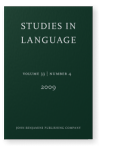Mark W. Post
List of John Benjamins publications for which Mark W. Post plays a role.
2022 Classifiers in a language with articles: Recent evolution of a typologically unusual Asian classifier system in the Tani languages of northeast India Classifiers, Aikhenvald, Alexandra Y. (ed.), pp. 239–267 | Article
Classifiers in Tani languages are similar in scale and semantic contents to the systems of better-known classifier languages such as Thai and Mandarin. Yet they are unusual in co-existing with an ancient and well-grammaticalised referential management system including both definite and… read more
2020 The distribution, reconstruction and varied fates of topographical deixis in Trans-Himalayan (Sino-Tibetan): Implications for the reconstruction of an early Trans-Himalayan environment Diachronica 37:3, pp. 368–409 | Article
Topographical deixis refers to a variety of spatial-environmental deixis, in which typically distal reference to entities is made in terms of a set of topographically-anchored referential planes: most often, upward, downward, or on the same level. This article reviews the genealogical and… read more
2013 Person-sensitive TAME marking in Galo: Historical origins and functional motivation Functional-Historical Approaches to Explanation: In honor of Scott DeLancey, Thornes, Tim, Erik Andvik, Gwendolyn Hyslop and Joana Jansen (eds.), pp. 107–130 | Article
Scott DeLancey’s analysis of person-sensitive TAME marking in Lhasa Tibetan – “a.k.a. conjunct-disjunct marking” or “egophoricity” – has stimulated considerable discussion and debate, particularly as previously little-known languages of the Tibeto-Burman area, as well as outside it, have come to be… read more
2011 Nominalization and nominalization-based constructions in Galo Nominalization in Asian Languages: Diachronic and typological perspectives, Yap, Foong Ha, Karen Grunow-Hårsta and Janick Wrona (eds.), pp. 255–288 | Article
This paper describes nominalization and nominalization-based construction in Galo, a Tibeto-Burman language of the Tani branch spoken in North East India. Nominalizers in Galo are divided into primary and secondary sets, while nominalization-based constructions are divided into two types:… read more
2009 The phonology and grammar of Galo “words”: A case study in benign disunity Studies in Language 33:4, pp. 934–974 | Article
“Words” may be independently defined and identified in Galo (Tibeto-Burman > Western Tani) in terms of relatively consistent and functionally well-motivated sets of phonological and grammatical criteria. However, these criteria very often fail to converge upon identification of the same formal… read more
2007 Grammaticalization and compounding in Thai and Chinese: A text-frequency approach Studies in Language 31:1, pp. 117–175 | Article





